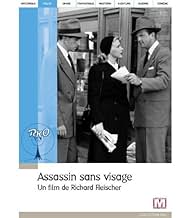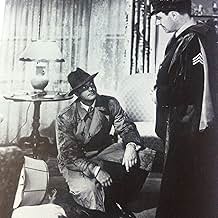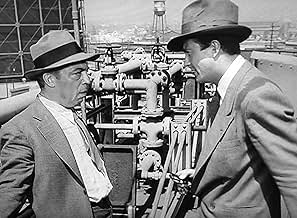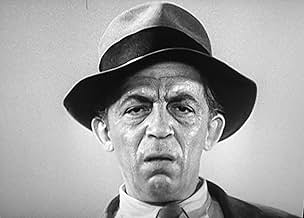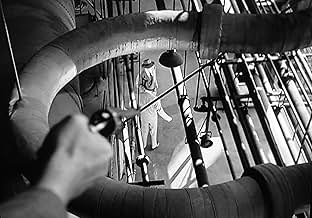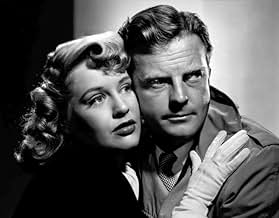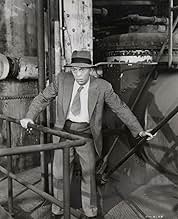VALUTAZIONE IMDb
6,5/10
2126
LA TUA VALUTAZIONE
Un poliziotto ossessionato rintraccia un serial killer sfuggente che strangola le sue vittime nelle notti di pioggia.Un poliziotto ossessionato rintraccia un serial killer sfuggente che strangola le sue vittime nelle notti di pioggia.Un poliziotto ossessionato rintraccia un serial killer sfuggente che strangola le sue vittime nelle notti di pioggia.
- Regia
- Sceneggiatura
- Star
Archie Twitchell
- Dixon
- (as Michael Branden)
Fred Aldrich
- Detective at Briefing
- (non citato nei titoli originali)
Walden Boyle
- Intern
- (non citato nei titoli originali)
Paul Bryar
- Sgt. Bryce
- (non citato nei titoli originali)
Wanda Cantlon
- Waitress
- (non citato nei titoli originali)
Maurice Cass
- Bookstore Owner
- (non citato nei titoli originali)
Martin Cichy
- Cop
- (non citato nei titoli originali)
Art Dupuis
- Detective
- (non citato nei titoli originali)
Recensioni in evidenza
Follow Me Quietly is directed by Richard Fleischer (with uncredited help from Anthony Mann) and adapted to screenplay by Lillie Hayward from a story written by Mann and Francis Rosenwald. It stars William Lundigan, Dorothy Patrick, Jeff Corey, Nestor Paiva and Paul Guilfoyle. Music is by Leonid Raab and cinematography by Robert De Grasse.
A serial killer known as "The Judge" is stalking the city, his modus operandi is to strike when it rains and to kill by strangulation. The police have loads of little clues but nothing solid to go on. The strain is starting to weigh heavy on Lt. Harry Grant (Lundigan), but he comes up with a genius idea to help catch the killer - a mannequin!
Not widely known, but once released to MOD home format it got more noticed and has been keenly sought out by fans of the great Anthony Mann. It has proved a little divisive so this fawning review should be taken with a little context. Clocking in at just under an hour in length, Fleischer's film is by definition a compact RKO "B" picture, but the quality of story, and the little slices of noir craft, ensure it's got plenty of strengths going for it.
In essence it's an early police procedural dealing with the hunt for a serial killer. There's a babe in the mix, Dorothy Patrick as an intrepid reporter who announcers herself to the film wearing a see through mackintosh, which of course is splendid. She teams up with Grant, not as a fatale, but as a sort of wry cohort, suggestion is evident, sexual tension even, but nothing is shoe-horned in to the pic. The cops are all stoic types, splendidly attired for period delights, but it's with Lundigan's head of investigations where the film gets its pulse beat. He gets in deep with the psychological aspects of the case, thinking like the killer, talking to the faceless mannequin that has been constructed out of clues left by the killer, the mirror images of the killer and mannequin are not exactly a million miles away from Lundigan himself. Cheeky is that.
Mann's stamp is all over the film, but Fleischer's work is evident for sure, an economical purist meets the crafty auteur, a fine match. Robert De Grasse (The Body Snatcher/Born to Kill) is a key component, operating with angles and shades when required, there's a distinct uneasy feel to proceedings. A few scenes grab the attention with full effect, akin to a spider inviting a fly to dinner, which all builds to a head, culminating in a blunderbuss finale at an oil refinery - cum - power plant. Only where White Heat (also 1949) went nighttime for its coup de grace, Follow Me Quietly did it in daylight. Cheeky is that.
It's not perfect. Some logic holes are there as regards the water effect with the killer, which also leads us to lament a lack of reasoning and understanding with the perpetrator. There's also a couple of instances where the mannequin is played in a rear shot by a real actor, why? I have no idea. While the best scene in the film, as Lundigan chats to the dummy in a darkened room - and the rain falls hard on the windows - brings about a reveal that makes no sense what so ever. Especially once "The Judge" is revealed. However, this is easy to recommend to noir heads and fans of police procedurals, and I loved it. 8/10
A serial killer known as "The Judge" is stalking the city, his modus operandi is to strike when it rains and to kill by strangulation. The police have loads of little clues but nothing solid to go on. The strain is starting to weigh heavy on Lt. Harry Grant (Lundigan), but he comes up with a genius idea to help catch the killer - a mannequin!
Not widely known, but once released to MOD home format it got more noticed and has been keenly sought out by fans of the great Anthony Mann. It has proved a little divisive so this fawning review should be taken with a little context. Clocking in at just under an hour in length, Fleischer's film is by definition a compact RKO "B" picture, but the quality of story, and the little slices of noir craft, ensure it's got plenty of strengths going for it.
In essence it's an early police procedural dealing with the hunt for a serial killer. There's a babe in the mix, Dorothy Patrick as an intrepid reporter who announcers herself to the film wearing a see through mackintosh, which of course is splendid. She teams up with Grant, not as a fatale, but as a sort of wry cohort, suggestion is evident, sexual tension even, but nothing is shoe-horned in to the pic. The cops are all stoic types, splendidly attired for period delights, but it's with Lundigan's head of investigations where the film gets its pulse beat. He gets in deep with the psychological aspects of the case, thinking like the killer, talking to the faceless mannequin that has been constructed out of clues left by the killer, the mirror images of the killer and mannequin are not exactly a million miles away from Lundigan himself. Cheeky is that.
Mann's stamp is all over the film, but Fleischer's work is evident for sure, an economical purist meets the crafty auteur, a fine match. Robert De Grasse (The Body Snatcher/Born to Kill) is a key component, operating with angles and shades when required, there's a distinct uneasy feel to proceedings. A few scenes grab the attention with full effect, akin to a spider inviting a fly to dinner, which all builds to a head, culminating in a blunderbuss finale at an oil refinery - cum - power plant. Only where White Heat (also 1949) went nighttime for its coup de grace, Follow Me Quietly did it in daylight. Cheeky is that.
It's not perfect. Some logic holes are there as regards the water effect with the killer, which also leads us to lament a lack of reasoning and understanding with the perpetrator. There's also a couple of instances where the mannequin is played in a rear shot by a real actor, why? I have no idea. While the best scene in the film, as Lundigan chats to the dummy in a darkened room - and the rain falls hard on the windows - brings about a reveal that makes no sense what so ever. Especially once "The Judge" is revealed. However, this is easy to recommend to noir heads and fans of police procedurals, and I loved it. 8/10
Interesting B movie starring William Lundigan and Dorothy Patrick about a police detective's search for a serial killer called "The Judge."
Gritty city scenes (although as one poster points out, it was probably an RKO set) enhance the atmosphere, and it's one of the things that makes "Follow Me Quietly" unusual.
Two more items of interest: A very exciting finale and the twist of having the police make a dummy model from everything they know about the perpetrator. In one scene, Lundigan is talking to the dummy's back, and it turns out to actually be the killer.
Lundigan was a good looking, poor man's Joel McCrea, perfect to be a detective in real life but not much of an actor. He doesn't exude much energy. Patrick, an attractive blonde, neither wildly glamorous or beautiful, gives a spirited performance as a tabloid reporter.
Gritty city scenes (although as one poster points out, it was probably an RKO set) enhance the atmosphere, and it's one of the things that makes "Follow Me Quietly" unusual.
Two more items of interest: A very exciting finale and the twist of having the police make a dummy model from everything they know about the perpetrator. In one scene, Lundigan is talking to the dummy's back, and it turns out to actually be the killer.
Lundigan was a good looking, poor man's Joel McCrea, perfect to be a detective in real life but not much of an actor. He doesn't exude much energy. Patrick, an attractive blonde, neither wildly glamorous or beautiful, gives a spirited performance as a tabloid reporter.
Superb, little-known noir - from a story by Anthony Mann (reportedly, he even directed some of it)! - which is certainly Fleischer's best from the genre after THE NARROW MARGIN (1952). Although it took me a while to warm up to the two leads (especially William Lundigan, given his crucial role of an obsessive police detective who is virtually a mirror-image of the vicious killer, a concept done to death in subsequent thrillers), their relationship is nicely developed and the rest of the cast - particularly Jeff Corey as the hero's wise-cracking sidekick and Edwin Max as "The Judge", when finally unmasked (actually a meek little man, not unlike the Peter Lorre of M [1931]!) - also performs admirably.
However, where the film - a brisk, taut 60 minutes! - truly scores is in its brilliant direction of the suspense sequences: the startling revelatory zoom of the villain's blank-faced dummy is particularly striking, whereas the scene in which we realize that "The Judge" has effectively replaced the dummy in Lundigan's office is genuinely creepy; these two sequences, not to mention the 'look' of the dummy itself, uncannily predate the Italian giallo genre by about 15 years - and I just have to wonder whether Mario Bava had actually watched this film somewhere down the line, and was perhaps reminded of it, when making his own seminal thriller BLOOD AND BLACK LACE (1964)!! Besides, the climax by the huge water tanks is quite splendid, and rarely has the rain been so ominously used as in this film!
A classic of its kind and, in hindsight, an influential one which, hopefully, Warners will consider releasing on DVD soon - as it's actually better than some of the noirs which are out already or have been announced by them...
However, where the film - a brisk, taut 60 minutes! - truly scores is in its brilliant direction of the suspense sequences: the startling revelatory zoom of the villain's blank-faced dummy is particularly striking, whereas the scene in which we realize that "The Judge" has effectively replaced the dummy in Lundigan's office is genuinely creepy; these two sequences, not to mention the 'look' of the dummy itself, uncannily predate the Italian giallo genre by about 15 years - and I just have to wonder whether Mario Bava had actually watched this film somewhere down the line, and was perhaps reminded of it, when making his own seminal thriller BLOOD AND BLACK LACE (1964)!! Besides, the climax by the huge water tanks is quite splendid, and rarely has the rain been so ominously used as in this film!
A classic of its kind and, in hindsight, an influential one which, hopefully, Warners will consider releasing on DVD soon - as it's actually better than some of the noirs which are out already or have been announced by them...
Normally lightweight William Lundigan is quite good as the hero cop of this quickie programmer. The rest of the cast is also quite good and the suspense remains high throughout. The plot is deceptively simple which is what makes the whole thing work in this atmospheric thriller. The only disappointment you'll have is that it's over so quickly.
I saw this film when I was 10 years old and it has haunted me all my life. At first I could only remember a guy waiting in a room for someone to come back, but then there was the idea of a crazy murderer who goes bizerk when it rains and then the memory of all these dummies in the police station and the murderer gets in there somehow, I don;t know how, but as he is in the room someone comes in, a policeman, just to check out the dummies and the murderer goes and sits in a chair so he won't be discovered because he looks like all the other dummies that are sitting there, and as he is sitting he is facing a window...and we see that it is beginning to rain...and there is a close up of his hand gripping the arm of the chair...all this is from my memory of the film as a 10-year old - when I managed to discover what the film was with the use of IMDb and got a video and looked at it - it all seemed pretty harmless stuff - I saw the film in a little cinema in Shaftesbury Dorset with my brother. My parents left us there and had no idea what the film was. The memory of the American streets, and the cars and the black and white quality have all stayed with me...
Lo sapevi?
- QuizFilmed in only sixteen days.
- BlooperWhen Detective Grant is in the office trying to solve the serial killings; he begins talking to the "Judge" dummy that is sitting on a chair with its back turned to him. After Collins interrupts him and they both leave the office; the dummy comes to life. It turns out that the real killer hid the dummy and took its place sitting on the chair. The puzzling thing is that the film does not explain how the killer manages to enter the Police precinct and the Detective's office without being detected. In addition, why would the killer want to go there and how did the killer in the first place even know the existence of a lookalike dummy. Finally, Detective Grant has been practically living with this dummy so it makes no sense that he couldn't tell even from the back that it was a real human being there. All these factors briefly interrupted the flow of the story.
- Citazioni
Lt. Harry Grant: Funny thing how he always strikes in the rain.
Sgt. Art Collins: Maybe he likes rain. Must be a fish.
- ConnessioniFeatured in Sterminate la gang! (1950)
I più visti
Accedi per valutare e creare un elenco di titoli salvati per ottenere consigli personalizzati
Dettagli
- Data di uscita
- Paese di origine
- Lingua
- Celebre anche come
- Seguimi in silenzio
- Luoghi delle riprese
- Azienda produttrice
- Vedi altri crediti dell’azienda su IMDbPro
- Tempo di esecuzione1 ora
- Colore
- Proporzioni
- 1.37 : 1
Contribuisci a questa pagina
Suggerisci una modifica o aggiungi i contenuti mancanti

Divario superiore
By what name was Follow Me Quietly (1949) officially released in India in English?
Rispondi

